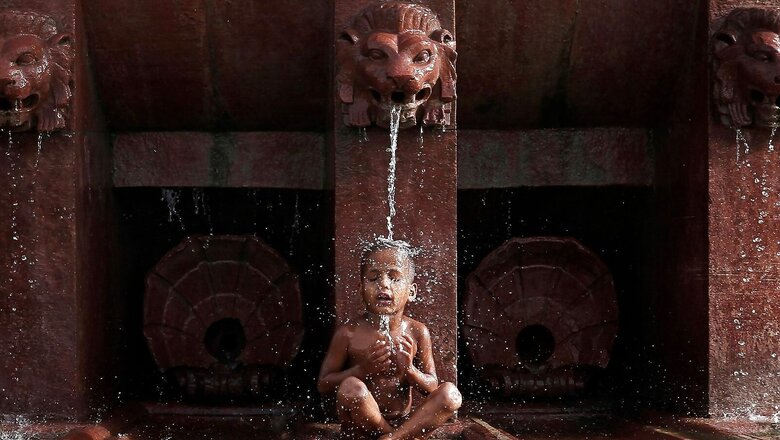
views
Millions are sweltering in a dangerous early summer heatwave across many countries in South Asia. India and Pakistan are facing debilitating heat, that has led to power and water shortages, as well.
Heatwaves have killed over 6,500 people in India since 2010, according to reports, and scientists say climate change is making them harsher and more frequent across South Asia.
“This is the first time I’ve seen such horrible weather in April. Usually, we’re prepared for this in May and onwards,” 30-year-old Delhi housewife Somya Mehra told AFP, as she and her family thirstily searched for cold drinks. “Today we stepped out because of our anniversary but otherwise I’m not stepping out at all. I’ve stopped sending my kid out to play”.
The states of Rajasthan, Gujarat and Andhra Pradesh imposed power cuts on factories as consumption for air conditioning and fans skyrocketed. Media reports said power stations were also facing shortages of coal, the main source of electricity.
Many regions also reported falling water supplies that will only worsen until the annual monsoon rains in June and July. Water shortages will hit farmers hardest, including those growing wheat as India aims to boost exports to help ease a global shortage due to the war in Ukraine.
“Heat wave conditions are likely to prevail over the northern plains as well as the central parts of the country throughout this week,” while “severe heat wave conditions” were forecast for west Rajasthan on May 1-2, the India Meteorological Department said Thursday in a weather review.
Hottest weather since 1961 in Pakistan
Temperatures are expected to be up to eight degrees higher than usual in parts of Pakistan, with the mercury peaking at 48 degrees in parts of rural Sindh on Wednesday, Pakistan’s Meteorological Society warned.
Farmers have to use water sparingly in a country where agriculture is the mainstay of the economy and accounts for around 40 percent of the workforce. “Public health and agriculture in the country will face serious threats due to the extreme temperature this year,” climate change minister Sherry Rehman told AFP.
Last month was the hottest March on record since 1961, the Pakistani Met office said.
Due to development limits in South Asia, the region is particularly vulnerable to climate hazards such as heatwaves. The fatal heatwave in Karachi in 2015 provides some significant information, according to a report by Thomson Reuters Foundation.
Pakistan’s Meteorological Department (PMD) was unable to foresee the occurrence that year, leaving authorities with little time to prepare. When the National Disaster Management Committee (NDMA) received instructions from the Prime Minister at the conclusion of the heatwave, it took action. The PMD and the NDMA were also chastised for their lack of collaboration.
The mortality toll was exacerbated by power and water shortages. K-electric, which supplied electricity to the majority of Karachi, was unable to satisfy the increasing demand from the public, and individuals who were suffering from the heat were left without power for long periods of time.
Heatstrokes were also induced by dehydration caused by fasting during the holy month of Ramadan, which affected several people, particularly the elderly. This time, the situation isn’t quite as bad as it was in 2015. Although forecasting has improved, Pakistan is still witnessing power outages that last up to 12 hours in some regions of the country.
With a new government in place for less than a month, the country’s politics are in disarray, potentially delaying action on the ground, as happened during the 2015 heatwave. Furthermore, Ramadan, which ends this weekend, may exacerbate the problem by requiring people to fast for 14-15 hours without drinking.
Nepal Not Behind
After suffering in record-breaking March heat, Kathmandu’s average temperature hit a 53-year high this week, according to a report by the Nepali Times. In mid-March, Dharan set a new record with 35.7°C. Heat waves are common in Nepal’s Tarai region, although not between March and April.
“Heat, temperature, and moisture combined will be the killers in South Asia,” Ajaya Dixit of the Institute for Social and Environmental Transition (ISET) Nepal was quoted in the report as saying. “If there is anything that will genuinely force people to respond to the climate crisis, it is frequent heat waves, because unlike other episodic extreme events, it is widespread and will impact everyone,” he said.
Bangladesh Is Also Sweltering
Weather service in Bangladesh has also forecasted that Bangladesh’s heatwave will persist. The Met Office reported in a bulletin on Thursday that a mild to moderate heat wave is sweeping through Khulna division and the districts of Faridpur, Madaripur, Gopalganj, Rangamati, Rajshahi, and Pabna, adding that it may persist, NewAge Bangladesh reported.
It’s possible that the weather will be mostly dry, with some gloomy skies in other parts of the country. Over the country, day and night temperatures may be essentially unchanged, the report said.
According to the bulletin, the highest temperature was 38.9 degrees Celsius in Rajshahi on Wednesday, while the lowest temperature was 22.6 degrees in Srimangal in Sylhet division.
What is the Future Ahead?
“Before human activities increased global temperatures, we would have seen the heat that hit India earlier this month around once in 50 years,” Mariam Zachariah from the Grantham Institute at Imperial College London told Reuters.
“But now it is a much more common event — we can expect such high temperatures about once in every four years. And until net emissions are halted, it will continue to become even more common”.
While ingenuity and solidarity can help communities adapt to increasingly brutal heatwaves, there is a limit, say Tom Matthews and Colin Raymond, climate scientists at King’s College London and California Institute of Technology, respectively.
“The range of weather humans can encounter on Earth – the ‘climate envelope’ – is shifting as the planet warms,” they warn. “Conditions entirely new to civilisation could emerge in the coming decades.” That means heat extremes that exceed what humans can survive.
A 2021 study reported that one in three deaths caused by extreme heat since 1991 can be linked to climate change. If you find yourself in a heat wave, Chloe Brimicombe, a PhD candidate studying climate change and its consequences for human health at the University of Reading, has some advice for staying safe: “Keep cool. If indoors, trying bathing your feet in cold water or have a shower … Close the curtains and open windows on the side not facing the sun,” she says.
With inputs from PTI, Reuters
Read all the Latest India News here




















Comments
0 comment